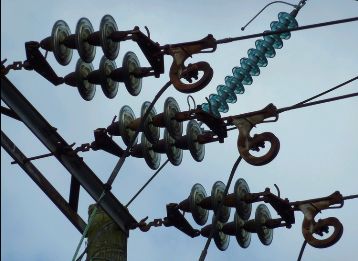Insulators for electrical installations

Live parts of electrical installations and individual devices must be reliably isolated from each other and from the ground. To perform these functions and fasten live parts, various insulators, which are divided into station, hardware and linear.
Station and hardware isolators used to fasten and isolate busbars in switchgear of power plants and substations or live parts of devices respectively. These insulators, in turn, are divided into supporting and control points... The latter are installed when the tires pass through walls and ceilings in the premises, as well as when they are taken out of buildings or used to remove current-carrying parts from the housings of the apparatus.
Line insulators are used to fasten conductors of overhead power lines and busbars of open switchgear.
Structurally and by purpose, insulators are divided into pins, suspended, supporting and through.
Pin insulators consist of one or two porcelain elements and are reinforced on metal pins, supports fixed in the traverses. All pin insulators provide rigid attachment of conductors to supports.
Line suspension insulators provide a loose connection of conductors to power line supports. Suspended disc insulators are connected to strings. In addition to pop, rod-shaped linear insulators are used, allowing to increase the dielectric strength due to the fact that they do not make it subject to breakdown.
Support insulators serve to support tires and contact parts of distribution and electrical devices.
Post insulators consist of one, two or three porcelain elements rigidly connected to each other and fixed on a cast iron pin. They are used as insulating supports in external distribution devices, in connection with which they have protruding wings for protection from atmospheric precipitation.
Post insulators also designed for outdoor installations. Such an insulator is a solid porcelain rod with protruding wings, on the end parts of which cast-iron caps for connecting insulators in columns and for attaching devices to them and in RU.
Bushings used to pull wires from transformer tanks, oil and air switches, and to insulate wires passing through the walls of buildings. They consist of a porcelain element through the inner cavity of which there is a current metal busbar or group of busbars.
One type of bushing insulators are inlets... The bearing part of the bushing is a copper tube, the main internal insulation is ceramic, liquid or oil paper, bakelite or other solid organic materials.
 Insulators must meet the following requirements: provide sufficient dielectric strength, determined by the strength of the electric field (kV / m), at which the insulating material loses its dielectric properties, have sufficient mechanical strength to withstand the dynamic forces that arise between the individual parts under voltage during a short circuit in the circuit to ensure the invariance of its properties under the influence of the environment (rain, snow, etc.), it has sufficient heat resistance, that is, it does not change its electrical properties when the temperature changes within certain limits, have a surface that is resistant to the impact of electric discharges.
Insulators must meet the following requirements: provide sufficient dielectric strength, determined by the strength of the electric field (kV / m), at which the insulating material loses its dielectric properties, have sufficient mechanical strength to withstand the dynamic forces that arise between the individual parts under voltage during a short circuit in the circuit to ensure the invariance of its properties under the influence of the environment (rain, snow, etc.), it has sufficient heat resistance, that is, it does not change its electrical properties when the temperature changes within certain limits, have a surface that is resistant to the impact of electric discharges.
The electrical characteristics of insulators include: nominal and breakdown voltage (minimum voltage at which the insulator breaks down), discharge frequency and power withstand voltage in dry state (dry discharge in which an overlap of the surface of the insulator occurs without loss of insulating properties ) and in rain (wet discharge, on the wetted surface of the insulator), pulsed 50% discharge voltages of both polarities.
The main mechanical characteristics of insulators include: minimum (nominal) breaking load (in Newtons) applied to the insulating head in a direction perpendicular to the axis, as well as dimensions and mass.
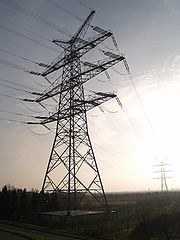 Line insulators are designed for insulation and fastening of wires on overhead lines and in switchgear of power plants and substations. They are made of porcelain or tempered glass. By design, insulators are divided into pin and pendant.
Line insulators are designed for insulation and fastening of wires on overhead lines and in switchgear of power plants and substations. They are made of porcelain or tempered glass. By design, insulators are divided into pin and pendant.
Clip insulators applied in air lines with a voltage of up to 1 kV and on overhead lines 6-35 kV (35 kV-rarely and only for wires with small cross-sections). For nominal voltage 6-10 kV and lower, insulators are made single-element, and for 20-35 kV - two-element.
Suspended mast-type insulator most common on overhead lines with a voltage of 35 kV and above. Suspended insulators consist of a porcelain or glass insulating part and metal parts - cap and rod, which are connected to the insulating part by means of a cement bond.
For overhead lines in areas with a polluted atmosphere, designs of pollution-resistant insulators with increased discharge characteristics and increased creepage distance have been developed.
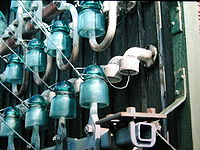 Suspended insulators gathered in Garlands that are supportive and tense. The former are mounted on intermediate supports, the latter on anchor supports. The number of insulators in a string depends on the line voltage. For example, in the supporting garlands of overhead lines with metal and reinforced concrete supports of 35 kV, there should be 3 insulators, 110 kV — 6 — 8, 220 kV — 10 — 14, etc.
Suspended insulators gathered in Garlands that are supportive and tense. The former are mounted on intermediate supports, the latter on anchor supports. The number of insulators in a string depends on the line voltage. For example, in the supporting garlands of overhead lines with metal and reinforced concrete supports of 35 kV, there should be 3 insulators, 110 kV — 6 — 8, 220 kV — 10 — 14, etc.
Clip-on insulators attached to supports by means of hooks or pins. If increased reliability is required, then not one, but two or even three pin insulators are installed on the anchor supports.
Station and hardware insulators, like linear insulators, in most cases are made of porcelain, which most fully meets the requirements. A number of parts of devices that perform the functions of insulation, especially those located inside the housings and in some cases filled with insulating oil, are made of Bakelite, Getinax and Textolite.
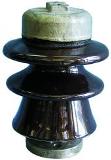 Metal fittings, that is, metal parts fixed to porcelain, are used to fasten the insulator to the base and the busbars or current-carrying parts of the apparatus to the insulator. The reinforcement is fixed on porcelain most often with the help of different types of cementing plasters with a coefficient of volume thermal expansion close to that of porcelain. To improve the quality of the insulators, their porcelain body is covered by a glaze on the outside.
Metal fittings, that is, metal parts fixed to porcelain, are used to fasten the insulator to the base and the busbars or current-carrying parts of the apparatus to the insulator. The reinforcement is fixed on porcelain most often with the help of different types of cementing plasters with a coefficient of volume thermal expansion close to that of porcelain. To improve the quality of the insulators, their porcelain body is covered by a glaze on the outside.
Depending on the type of installation, use insulators for indoor or outdoor installation... Outdoor insulators have a more developed surface, due to which the microdischarge voltage increases, which ensures reliable operation both in rain and in dirty conditions.
Insulators for different nominal voltages differ in the active height of the porcelain, and for different destructive mechanical forces - in diameter.
Support insulators can be divided into support rod and support pin... Post rod insulators have a solid or solid porcelain rod with convex ribs.
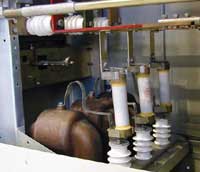 Insulating fittingsDesigned to withstand significant mechanical loads, it consists of oval or square flanges with bolt holes on the bottom and metal heads with threaded holes for fixing the wire on top.
Insulating fittingsDesigned to withstand significant mechanical loads, it consists of oval or square flanges with bolt holes on the bottom and metal heads with threaded holes for fixing the wire on top.
Insulators designed for lower mechanical stress do not have flanges and heads. They have metal inserts with threaded holes fixed in the recesses of the porcelain rod. These insulators are smaller and lighter because of the internal fittings.
Insulators for indoor installation for voltages up to 35 kV, OF series have a conical porcelain body with one or two small ribs. External mounting support rod insulators, ONS series differ from those considered by the more developed fins.They are made for voltages 10 — 110 kV.
 Insulator support pins from the ОНШ series intended for external installation. They have a porcelain body with far protruding ribs (wings) to keep the rain out. The insulator is attached to the base using a cast iron flanged pin. On top is a cast iron cap with threaded holes for fixing live parts.
Insulator support pins from the ОНШ series intended for external installation. They have a porcelain body with far protruding ribs (wings) to keep the rain out. The insulator is attached to the base using a cast iron flanged pin. On top is a cast iron cap with threaded holes for fixing live parts.
Inner bushings up to 35 kV have a hollow porcelain body with small ribs. For fixing the insulator in the ceiling (wall), a flange is provided in its middle part, and metal caps for fixing the wire are provided at the ends. Bushings with rated currents up to 2000 A are equipped with rectangular bars.
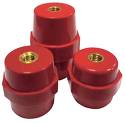 Insulators for current of 2000 A and higher, the so-called "Car tire", supplied without rods. These end insulators have specially designed end caps that hold steel strips with rectangular cutouts through which the busbar passes.
Insulators for current of 2000 A and higher, the so-called "Car tire", supplied without rods. These end insulators have specially designed end caps that hold steel strips with rectangular cutouts through which the busbar passes.
Flanges and caps for insulators with high rated current (typically more than 1000 A) are made of non-magnetic materials — special grades of cast iron, Silimin — to avoid additional losses due to induced currents.
Bushings, one part of which is operated outdoors and the other part indoors or in oil, such as bushings for transformers and oil circuit breakers, make them asymmetrical. The air part of the porcelain body has more developed ribs.
Bushings for voltages 110 kV and above, so-called «sleeves», in addition to porcelain, have an oil barrier or, in newer designs, oil paper insulation. In the latter case, layers of wire paper with aluminum foil wire spacers between them (capacitor sleeve) are superimposed on the conducting rod.The capacitor sleeve provides uniform potential distribution both axially and radially. These records are usually sealed.
